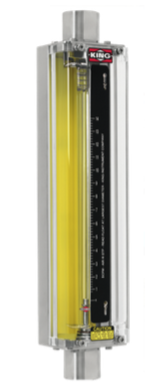 |
| Industrial Rotameter Flow Meters Courtesy King Instrument |
Rotameters are very specific to each flow measurement application. It's important that you know your fluid properties, ambient conditions, connection and readability specifications.
Start with these selection parameters:
- Desired flow rate range
- Fluid specific gravity
- Ambient temperature
- Operating and maximum pressure
- Line size
- Connection type
- Connection orientation
- With or without a valve
- Material requirements to accommodate fluid
- Scale units of measure. Smallest scale divisions needed.
For each application, it's advisable to work closely with a sales engineer to gather all the needed information and coordinate the product selection process.
Consult with a product specialist about your flow measurement application. A combination of your process knowledge and their product expertise will produce the best solution.
Here are some things to consider for potential rotameter applications:
- Simple design and operation provide a modest cost solution.
- No external power is required for operation. Inherent fluid properties and gravity are used to measure flow rate.
- Clear glass used for the measuring tube is highly resistant to thermal shock and corrosion.
- Instrument orientation must be vertical, with fluid flowing upward.
- Scale graduations are accurate for a given substance at a given temperature, making the devices application specific.
- Operation of the rotameter may be impacted by changes in the viscosity of the fluid. Consult with a product and application specialist to explore your application.
- Direct flow indication provides resolution that may not be as good as some other flow measurement methods.
- Visual reading of the scale is subject to uncertainty due to float oscillation, parallax, and location on the scale.
- Make sure the fluid turbidity, or another fluid characteristic will not obscure the visibility of the float.
Consult with a product specialist about your flow measurement application. A combination of your process knowledge and their product expertise will produce the best solution.

